|


The
atria contract, pumping blood into the ventricles just before ventricular
contraction. The electrical current ("depolarization") that causes atrial
contraction is conducted very slowly to the ventricles to allow time for
blood to fill the ventricles.
The
AV Node, the only electrical connection between the atria and the ventricles,
conducts the depolarization impulse (from the contracting atria to the
ventricles) very slowly. This provides a brief pause for ventricular filling
after atrial contraction. On EKG, the P wave (representing atrial contraction)
is normally followed by a short span of level baseline (pause) before
the QRS complex (ventricular contraction).
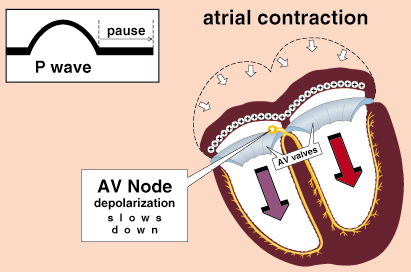
From Rapid Interpretation of EKG's copyright © 2017 COVER Publishing Co. Inc.
In
some people, an anomalous conduction pathway, the "Kent bundle," connects
the atria and the ventricles, short-circuiting the AV Node. The anomalous
conduction pathway allows rapid conduction to the ventricles without the
normal delay. This produces Wolff Parkinson White (WPW) syndrome, which
is characterized by conduction of the atrial depolarization current to
the ventricles immediately after atrial contraction.
On
the EKG of patients with WPW syndrome (see page 171, 6th ed.), the usual
short span of baseline following the P wave is replaced by a curving "delta
wave," representing too-early stimulation ("pre-excitation") of a portion
of the ventricles. This is easy to detect in most leads as a gentle upward
curve that connects the P wave and the QRS complex.
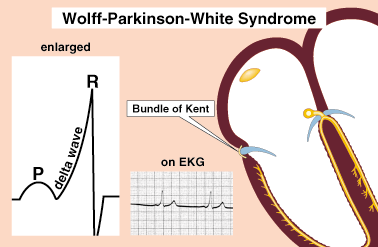
From Rapid Interpretation of EKG's copyright © 2017 COVER Publishing Co. Inc.
Pre-excitation
of the ventricles, per se, is not serious, but it may lead to rapid ventricular
rhythms that are dangerous, particularly in elderly persons or those with
heart conditions. WPW is very treatable; the Kent bundle can be ablated
(destroyed) using a radio frequency intracardiac catheter. Therefore,
early detection of delta waves on EKG can allow these patients to enjoy
a normal life span.
__________________________________________
Brugada syndrome is a recently recognized cause of sudden death in apparently
healthy individuals. It is responsible for about one-half of sudden deaths
in young persons without structural heart disease, therefore early detection
is critical. This familial condition is due to malfunctioning sodium (Na+)
channels in the heart cells.
Although
the deadly arrhythmias (abnormal rhythms) that victims experience cannot
be prevented, they can be successfully treated with an Implantable Cardioverter-Defibrillator
(ICD), which corrects the arrhythmia immediately upon its occurrence.
But persons with this syndrome must be identified in order to provide
this life-saving treatment.
On
the standard EKG, there is usually a short segment of level baseline ("ST
segment") immediately following the (normally narrow) QRS complex. The
ST segment is normally level with the baseline in all EKG leads.
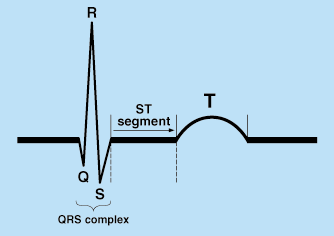
From Rapid Interpretation of EKG's copyright © 2017 COVER Publishing Co. Inc.
However
in Brugada syndrome (see pages 268, 310, 6th ed.), the QRS is widened
and has two upward peaks in (chest) leads V1 and V2, and the ST segment
is elevated. The ST segment begins at the second peak of the widened QRS
then slopes gradually downward. In Brugada syndrome, lead V3 also has
a wide QRS and ST elevation that is stereotypical for this condition.
All medical personnel who frequently observe cardiac monitors or EKG strips
should make a mental note of this EKG pattern.
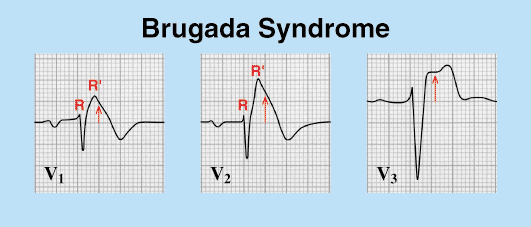
From Rapid Interpretation of EKG's copyright © 2017 COVER Publishing Co. Inc.
If
you keep a mental reference of the EKG morphology of Brugada syndrome
in leads V1, V2, and V3, perhaps you can prevent an untimely, unnecessary
death. Since lead MCL1, which is a variation of leads V1 and V2, is the
most common lead used for cardiac monitoring, all medical personnel should
be familiar with the EKG morphology of this deadly syndrome. During your
career you can prevent an untimely death by referring your patient for
proper life-saving treatment.
__________________________________________________
Rarely
are we warned of an impending myocardial infarction long before it occurs.
However, in patients with Wellens syndrome, stenosis (narrowing) of the
Anterior Descending (the most important) branch of the Left Coronary Artery
is revealed on EKG in patients with negligible or even absent symptoms.
Therefore it is important the all medical personnel be ever-vigilant for
the telltale signs of this important syndrome.
On
normal EKG's the T wave (which follows the ST segment) is usually upright
or somewhat flattened in leads V2 and V3. However, in the EKG of some
patients with stenosis of the Anterior Descending coronary artery, the
T waves are markedly inverted (upside down) long before symptoms are present.
For those patients with Wellens syndrome (see pages 265, 310, 6th ed.),
this easily detected EKG sign is life-saving only if the person(s) observing
the EKG are savvy enough to recognize this important problem. Be that
person!
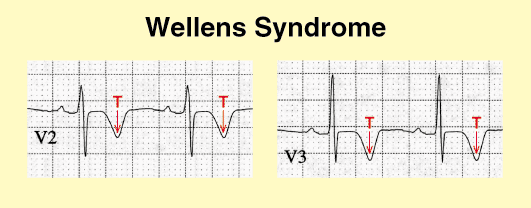
From Rapid Interpretation of EKG's copyright © 2017 COVER Publishing Co. Inc.
Stenosis
of the Anterior Descending coronary artery is very treatable, and it is
important that treatment be initiated before the artery is totally occluded
causing myocardial infarction... even death. Using a special expandable
catheter placed in the stenosed artery, the narrowed area can be dilated
by a cardiologist using a procedure known as "angioplasty."
Currently,
most angioplasty procedures employ the implantation of a metal mesh tube
known a "stent" inside the artery, to keep it open and prevent re-stenosis of this
vital artery. Intervention using angioplasty with stenting can indeed
be life saving, but your recognition of Wellens syndrome is the critical
link.
_____________________________________________________
There
is a group of familial syndromes collectively known as Long QT syndrome
(see pages 28, 158, 310, 6th ed.). There are at least six different forms
of Long QT syndrome thought to be caused by dysfunctional ion channels;
they all can produce dangerous or deadly ventricular arrhythmias. Early
treatment with proper medications should be instituted as soon as this
syndrome is detected, ideally during childhood. There are, however, perhaps
many thousands of people with undetected Long QT syndrome who require
treatment.
Although
the heart rate varies somewhat (in response to physiological needs), the
QT interval (measured on EKG from the beginning of the QRS to the end
of the T wave) always remains less than one-half of the cardiac cycle.
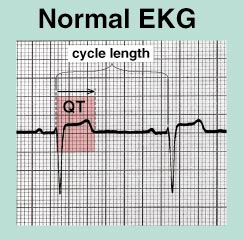
From Rapid Interpretation of EKG's copyright © 2017 COVER Publishing Co. Inc.
With
Long QT syndrome the QT interval is longer than one-half the length of
the cardiac cycle (usually measured from R wave to R wave). A quick glance
at any lead will reveal the lengthened QT interval.
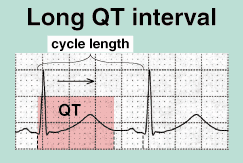
From Rapid Interpretation of EKG's copyright © 2017 COVER Publishing Co. Inc.
Lengthening
of the QT interval can be caused by a variety of medications that block
ion channels (usually K+ channels). Certain types of cardiac pathology
or metabolic conditions can also lengthen the QT, but in general, lengthening
of the QT interval, regardless of the etiology, predisposes the patient
to Torsades de Pointes (see pages 158, 310, 6th ed.) and other dangerous
arrhythmias. Don't overlook it!
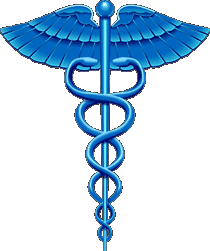
If
you detect any of these syndromes and refer the patient for treatment,
please share your experience with us. Lifesaving measures are not always
emergency measures. You can derive just as much satisfaction, pride, and
patient gratitude by preventing an untimely demise.
|
